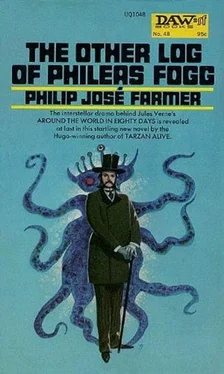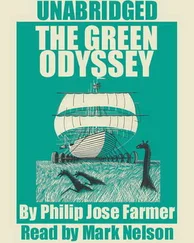Philip Farmer - The Other Log of Phileas Fogg
Здесь есть возможность читать онлайн «Philip Farmer - The Other Log of Phileas Fogg» весь текст электронной книги совершенно бесплатно (целиком полную версию без сокращений). В некоторых случаях можно слушать аудио, скачать через торрент в формате fb2 и присутствует краткое содержание. Жанр: Фантастика и фэнтези, на английском языке. Описание произведения, (предисловие) а так же отзывы посетителей доступны на портале библиотеки ЛибКат.
- Название:The Other Log of Phileas Fogg
- Автор:
- Жанр:
- Год:неизвестен
- ISBN:нет данных
- Рейтинг книги:3 / 5. Голосов: 1
-
Избранное:Добавить в избранное
- Отзывы:
-
Ваша оценка:
- 60
- 1
- 2
- 3
- 4
- 5
The Other Log of Phileas Fogg: краткое содержание, описание и аннотация
Предлагаем к чтению аннотацию, описание, краткое содержание или предисловие (зависит от того, что написал сам автор книги «The Other Log of Phileas Fogg»). Если вы не нашли необходимую информацию о книге — напишите в комментариях, мы постараемся отыскать её.
The Other Log of Phileas Fogg — читать онлайн бесплатно полную книгу (весь текст) целиком
Ниже представлен текст книги, разбитый по страницам. Система сохранения места последней прочитанной страницы, позволяет с удобством читать онлайн бесплатно книгу «The Other Log of Phileas Fogg», без необходимости каждый раз заново искать на чём Вы остановились. Поставьте закладку, и сможете в любой момент перейти на страницу, на которой закончили чтение.
Интервал:
Закладка:
There are other inconsistencies. According to the The Mysterious Island, Nemo is an Indian Prince Dakkar, and presumably at least some of such a man’s followers would be Indians. This could hardly have escaped the observation of Professor Aronnax, who for months watched them fishing and working about the Nautilus. Yet never does it seem to occur to him that any are Orientals. Instead, he says that all are Europeans. No matter how dubious in the eyes of modern science identification of nationality from appearance may be, it is unlikely that a veteran biologist would mistake, after close and repeated observations, some two dozen Hindus for Europeans-especially Irishmen! Furthermore, in The Mysterious Island (p. 460) Captain Nemo defends the sinking of the hostile warship witnessed by Professor Aronnax on the grounds that he “was in a narrow and shallow bay-the frigate barred my way.” Yet the Professor’s account (Twenty Thousand, pp. 473-82) unquestionably proves that for over twenty-four hours Captain Nemo deliberately lured the frigate to follow him until it suited his whim to turn and sink her.
Many more such instances may be piled up, but I think the conclusion is too obvious for us to cite them. The Mysterious Island is a work of fiction turned out by a professional novelist who, after some editing of the manuscript of Professor Aronnax to ensure its popular sale, decided to capitalize on its success by writing an entirely imaginary sequel and, in doing so, to rehabilitate a rather brutal man by painting him as a Byronic hero with a heart of gold-a procedure thoroughly compatible with the literary fashion of the day. We must dismiss it, and with this dismissal must also vanish any and all reliance upon this later volume’s account of Captain Nemo’s character, moral values, and life as “Prince Dakkar.”
Having disposed of The Mysterious Island as a source of information, let us now turn our attention to Twenty Thousand Leagues. Since this volume appears to be a novelist’s rewriting or editing of Professor Aronnax’s memoirs, we may put some faith in matters of fact observed by the professor. However, we should be more cautious in acceptance of matters of interpretation, for here the romantic Byronic aura which Aronnax and Verne saw surrounding the captain may mislead us. Consider the concept of Captain Nemo as the half-noble, half-ruthless, golden-hearted, disillusioned idealist, who loves the oppressed in general, his crew in particular, and who has provided an “Ark of Refuge” for a selected few to whom he is bound by ties of mutual devotion. Just how does the man Nemo really treat this crew of his? First of all, we should estimate how many men are on the Nautilus. From various bits of information it is clear that he cannot have had fewer than twenty-four crewmen in the original group and he may have had thirty or more. The living quarters provided for these men are very interesting. The description of the berth-room in which they seem to have spent practically all of their existence when not engaged in their duties indicates that the room could not have measured more than 22 feet by 16 feet. If we line this room with tripledecker berths, we can just fit twenty-four men (the smallest possible number) into these quarters, generously leaving clear in the center a floor space of 10 feet by 16 feet, in which they may dress, store their clothes, eat, lounge, and otherwise amuse themselves. These are slum conditions of the foulest sort. But perhaps Captain Nemo, whose bedroom is described as “severe almost… monkish,” lived under equally Spartan conditions? Well, his private suite, into which the crew never intruded, consisted of the following apartments in addition to his fifteen foot bedroom; a dining room (15 feet long) equipped, among other articles, with “exquisite paintings” and with oak and ebony sideboards bearing “china, porcelain, and crystal glass of inestimable value” (p. 81); a library (also 15 feet in length and running like the former room, the width of the ship) containing overstuffed divans upholstered in brown Morocco, movable desks, a huge table for periodicals, cigars, a bronze brazier for a cigar lighter, and a private collection of 12,000 books (pp. 85-87); a magnificent museum-drawing room (30 feet by 18 feet) provided with an arabesques ceiling, pictures “of great value” by Raphael, Leonardo, Titian, Rubens, etc. (“the greater part of which” Professor Aronnax “had admired in the galleries of Europe”), statues of bronze and marble, a large piano-organ, an invaluable collection of marine life in “splendid glass cases,” and pearls some of which were “larger than a pigeon’s egg” and which surpassed the most valuable pearl hitherto known. With this at his disposal, I think that one can see how Captain Nemo managed to survive the hardships of that severe, almost monkish bedroom.
In any event, the account does not fit the concept of a loving master served by an admiring group of acolytes. It does, however, fit the picture of the sybaritic commander of an old-fashioned warship living in luxurious quarters and ruling with an iron hand a crew of tough fighting men whose fear of their captain and expectation of high financial gain may make them willing to put up with physical discomfort.
One or two puzzling events are reported by the professor. The events we can accept, but his interpretation is less reliable. On a very rough day when the captain, the mate, and the professor are on deck, the two officers observe through a telescope an object so distant that the professor (whose vision seems normal) is unable to see even a speck with his naked eye. The officers are greatly excited, the professor and company are heaved into the brig again, doped, and a ship is sunk by the Nautilus (pp. 216-220). These are the facts; the interpretations that we are given is this: Captain Nemo on first sighting the ship immediately recognized it-necessarily by its flag-as belonging to that unidentified nation which he so loathed, and consequently rammed it with the ship spur mounted on the bow of his submarine. Yet a little thought shows us that this cannot be entirely correct: if the ship was so far away that Professor Aronnax was unable to distinguish it at all with the naked eye, how could the man Nemo even with a telescope possibly recognize its colors? The conclusion, therefore, is that the one way Nemo could know that here was the ship upon which he had designs was by being given information that at this date and in this location, just one particular vessel could be expected. Yet our saline recluse could possess up-to-date information concerning shipping only from some source external to the Nautilus. And of this supposition we have confirmation. He appears to have devoted considerable effort to scooping up the treasure from the sunken ships in the Bay of Vigo. About a million dollars in gold (pp. 300-01) he sent ashore in the pinnace after his intermediary, one Nicholas Pesca (an amphibious individual who appears to have devoted most of his time to swimming from one island of the Cyclades to another), had, during an evening dip, swum out to the Nautilus (p. 299). The interpretation which Captain Nemo skillfully plants in the professor’s mind (pp. 326-27) is that he, as a friend to all oppressed groups, has devoted his wealth to the Cretans, who at this time were in revolt against Turkish rule. The facts are that he is in the habit of sending part of his takings ashore and that he does have certain connections with civilization which might supply him with data concerning shipping and cargo schedules.
Now, following Watson’s method (since we dare not arrogate to ourselves the techniques of the Master), let us see what conclusions we can come to concerning the puzzling character of the man Nemo:
1. He had a wide educational background-especially in biology, music, sculpture, painting, and history.
Читать дальшеИнтервал:
Закладка:
Похожие книги на «The Other Log of Phileas Fogg»
Представляем Вашему вниманию похожие книги на «The Other Log of Phileas Fogg» списком для выбора. Мы отобрали схожую по названию и смыслу литературу в надежде предоставить читателям больше вариантов отыскать новые, интересные, ещё непрочитанные произведения.
Обсуждение, отзывы о книге «The Other Log of Phileas Fogg» и просто собственные мнения читателей. Оставьте ваши комментарии, напишите, что Вы думаете о произведении, его смысле или главных героях. Укажите что конкретно понравилось, а что нет, и почему Вы так считаете.












